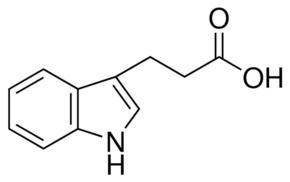Trade names Oxigon CAS Number 830-96-6 Molar mass 189.2105 g/mol | ATC code none PubChem CID 3744 | |
 | ||
Legal status US: UnscheduledUN: Unscheduled Synonyms Conjugate base:Indole-3-propionate | ||
3-Indolepropionic acid (IPA), or indole-3-propionic acid, is a potent neuroprotective antioxidant and plant auxin that is being studied for therapeutic use in Alzheimer's disease. It is endogenously produced by human microbiota and has only been detected in vivo when the species Clostridium sporogenes is present in the gastrointestinal tract. As of April 2016, C. sporogenes, which uses tryptophan to synthesize indole and subsequently IPA, is the only species of bacteria known to synthesize IPA in vivo at levels which are subsequently detectable in the blood plasma of the host.
The neuroprotective, antioxidant and anti-amyloid properties of IPA were first reported by a group of investigators in July 1999, led by Dr Pappolla and Dr. Poeggeler at the University of South Alabama.
IPA is an even more potent scavenger of hydroxyl radicals than melatonin, the most potent scavenger of hydroxyl radicals that is synthesized by human enzymes. Similar to melatonin but unlike other antioxidants, it scavenges radicals without subsequently generating reactive and pro-oxidant intermediate compounds.
